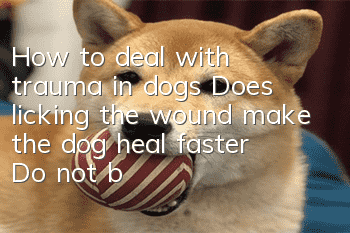How to deal with trauma in dogs? Does licking the wound make the dog heal faster? Do not be silly

Dogs licking wounds may cause illness
1. The concentration of bactericidal substances in dog saliva is very low and has almost no sterilizing effect;
2. The dog's mouth may contain other pathogens (dogs like to lick everywhere and have unhealthy oral hygiene). If accidentally brought to a wound, it can cause infection.
3. Although the enzymes in saliva can kill some bacteria, the types of bacteria they target are limited.
How to deal with dog trauma
1. Shave the hair from the wound
When you find that a certain part of your dog is injured and bleeding, make sure that the wound is not serious. You can shave off the hair adhering to the wound to expose the wound. Prepare a ring-shaped isolation tape 2cm away from the wound for centralized cleaning later. and disinfect wounds.
Note: During the shaving process, you must be careful and gentle to avoid secondary injuries!
2. Clean and disinfect the wound
When the wound is exposed, cleaning and disinfection should begin. First, briefly check whether there is any foreign matter in the wound. If there is any foreign object, use sterile tweezers to remove it. (Please send to a doctor for larger foreign objects)
Use saline or iodophor and other disinfectants to start cleaning the wound, and squeeze out the blood and dirt from the wound while rinsing it. Rinse repeatedly from the inside out, and use gauze strips to disinfect deep wounds. (If the wound is deep, it is still recommended to seek medical treatment.) After repeated cleaning, use sterile gauze to wipe away the excess disinfectant around the wound.
Note: If the dog feels pain and resists when the wound is being treated, it is best to muzzle the dog to prevent it from being attacked.
3. Apply medicine to the wound
After cleaning the wound, you must start applying medicine to the wound. Anti-inflammatory drugs such as red (chlortetracycline) ointment and Yunnan Baiyao can be used to prevent wound infection. For deep wounds, the medication should also go deep.
4. Bandage the wound
Whether or not you should wrap the wound with gauze depends on the situation. If the wound is large, it must be bandaged to avoid bacterial infection. However, if the wound is small but deep, bandaging is not recommended to avoid anaerobic and other bacterial infections. In addition, it is best not to bandage the wound if the weather is hot.
Cut the gauze to an appropriate length and width according to the size of the wound. Wrap it patiently and gently and secure it with tape. Be careful not to wrap it too tightly to avoid local blood circulation. In addition, it is best not to let the tape that fixes the gauze come into contact with the dog's skin to avoid causing allergies.
The thickness of the gauze is also very delicate. Thicker gauze can be used in the early stage of the wound to ensure the temperature and humidity of the wound, which is beneficial to wound healing. At a later stage, gauze canThin to keep the wound dry.
Note: In order to prevent your dog from biting the gauze and licking the wound, you can wear an Elizabethan ring.
5. Post-processing and observation of wound healing
After bandaging the wound, not everything will be fine. You must pay more attention to the wound healing in the future to prevent infection. It is best to change the gauze every day to keep the wound clean and reduce the chance of wound infection.
In the early stage, the wound will secrete a lot of purulent material, so these inflammatory or purulent secretions should be removed in time. When there is less purulent secretion, it is the granulation growth stage. At this time, there is no need to clean the wound except changing gauze, so that it can heal faster.
Precautions for treating wounds
1. Make sure the wound is clean. Gauze, antiseptic, and owner's hands must be sterile. Disinfect hands thoroughly before cleaning the wound.
2. Treat wounds carefully and gently and quickly.
3. The wound should be kept dry. If the wound is small, it is best to expose it.
4. If necessary, combine with systemic medication to prevent infection and improve immune resistance.
5. Observe the wound closely and pay attention to redness, swelling and suppuration.
6. If after a few days, the wound does not scab, or even there is still blood or secretions flowing out, it is best to take it to the hospital.
- What do dogs eat to protect their stomach? It is important to protect their stomach and treat gastrointestinal diseases in dogs.
- How to tell if your dog is fat? Is your dog overweight?
- Will your dog catch a cold if you blow the air conditioner? What should you do if your dog catches a cold if you blow the air conditioner?
- What should you pay attention to when your dog drinks water? Don’t be careless when it comes to your dog’s drinking water.
- The dog's mouth bites and shakes. Why does the dog's mouth occasionally shake and bite?
- How to cut a dog's hair? Do you know how to cut a dog's hair correctly?
- Can dogs eat raw eggs? Why can’t dogs eat egg whites?
- Common Dog Problems in Summer How to Deal with Different Dog Problems
- How to keep dogs away from skin diseases. If you do this, will you see if your dog will still be infected with skin diseases?
- What causes anorexia in dogs? Dogs will become anorexic due to lack of exercise. Hounds run at least 5KM every day.



